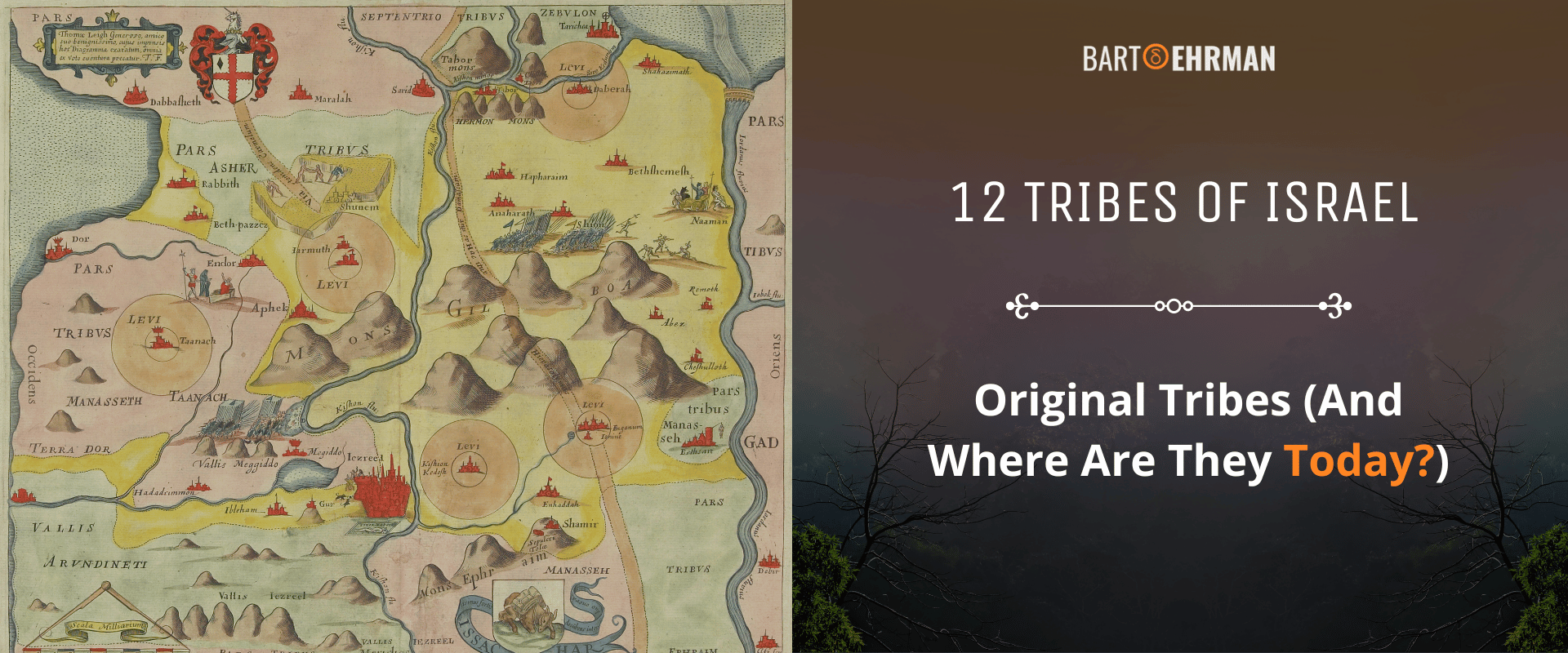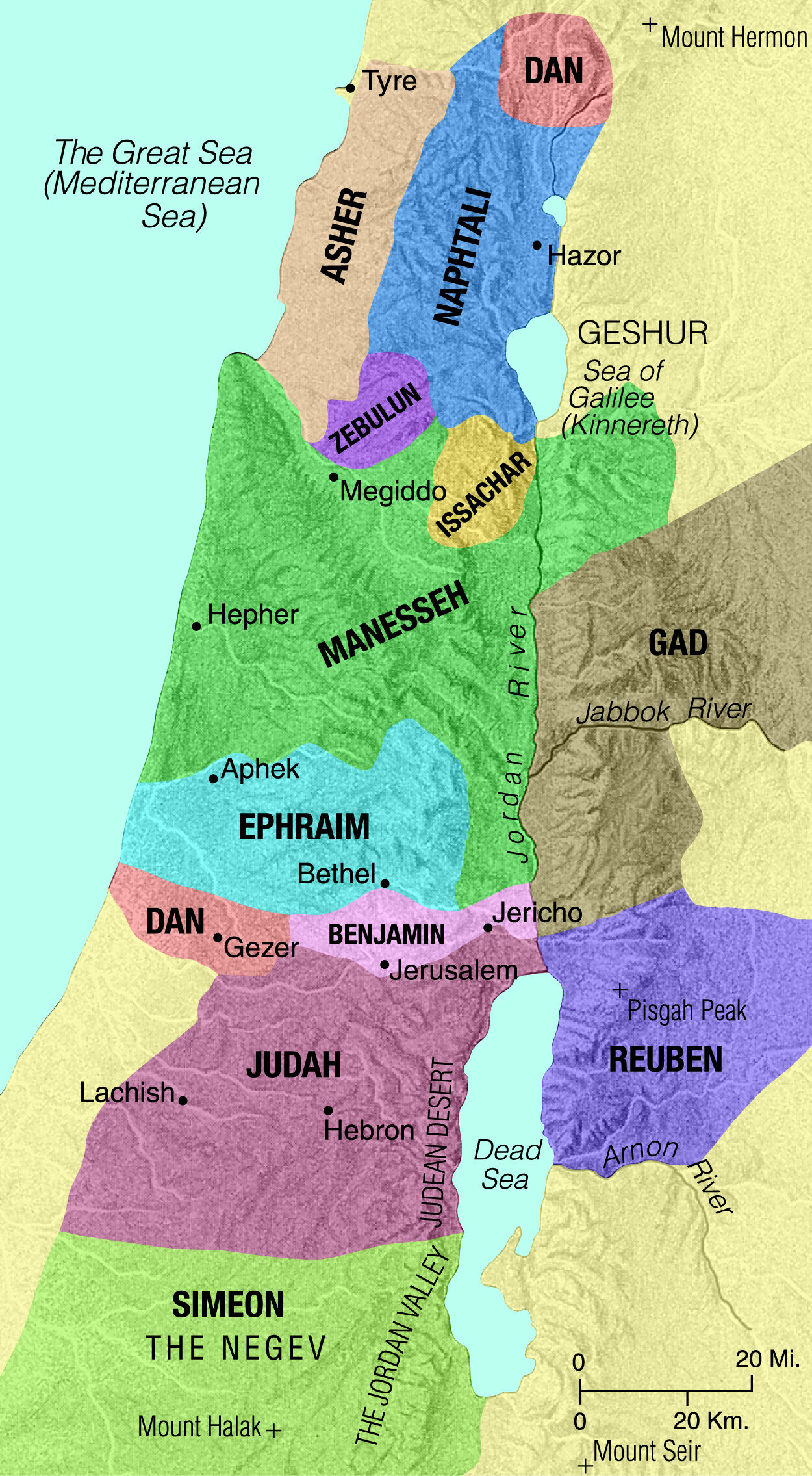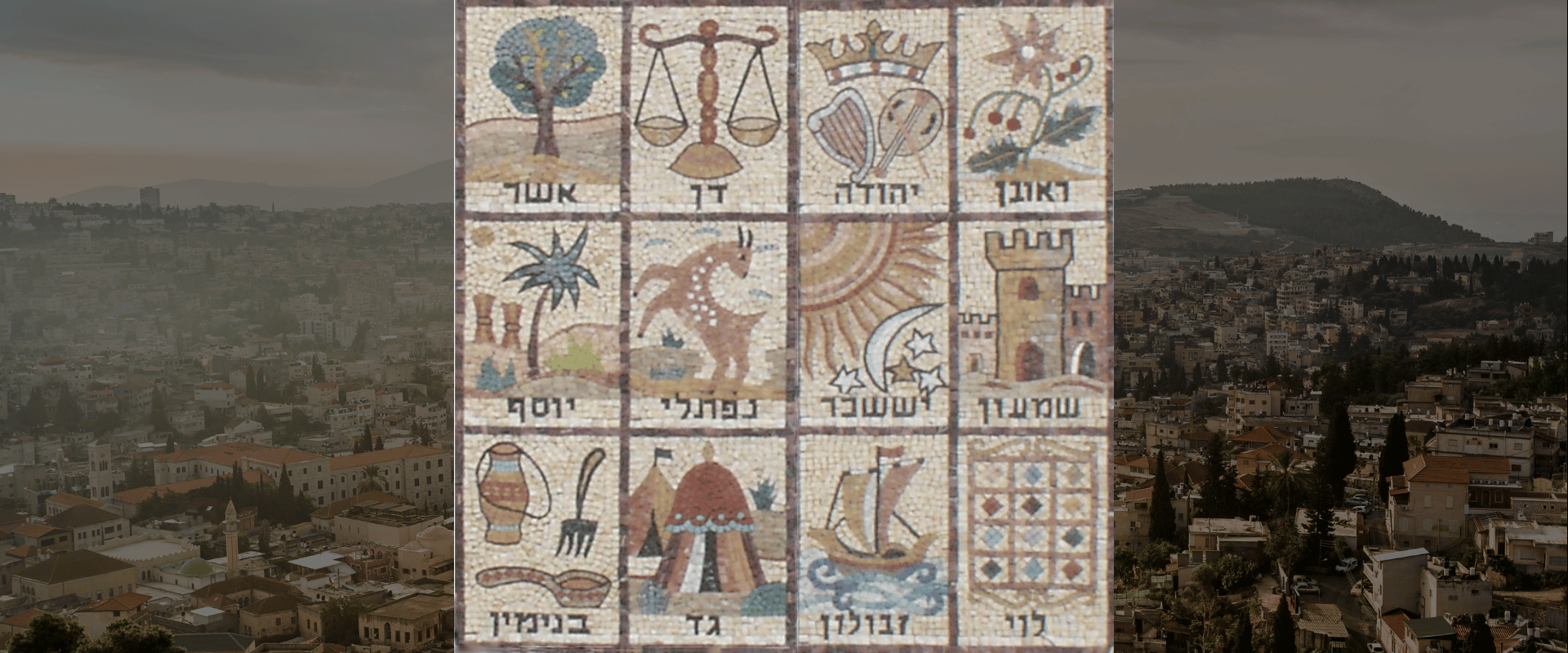12 Tribes of Israel: Original Tribes (And Where Are They Today?)

Written by Joshua Schachterle, Ph.D
Author | Professor | Scholar
Author | Professor | BE Contributor
Verified! See our editorial guidelines
Verified! See our guidelines
Date written: May 18th, 2024
Disclaimer: The views and opinions expressed in this article belong to the author and do not necessarily match my own. - Dr. Bart D. Ehrman
Israel’s identity has been intimately tied to the 12 tribes of Israel for millennia. The tribes are explicitly named in the Bible which traces their roots back to the ancient Jewish patriarchs. But were the tribes real or are they merely part of a foundational myth?
In this article, I’ll explore what the Bible says about the 12 tribes of Israel, what scholars say about their historicity, and what the ongoing quest to find the lost tribes can tell us.

What Does the Bible Say About the 12 Tribes of Israel?
In the tradition of the Hebrew Bible, the 12 tribes of Israel are formed, and thus named, for the sons of the Jewish patriarch Jacob (whose name is changed to Israel by God). The Jewish tribes are named Reuben, Simeon, Levi, Judah, Issachar, Zebulun, Benjamin, Dan, Naphtali, Gad, Asher, Ephraim, and Manasseh, depending on the list (I realize that this is 13 tribes. More on the number of tribes later).
Notice that in our list above, there is no tribe of Joseph, one of the sons of Jacob. This is because in some biblical lists, the tribe of Joseph was split into two, named Ephraim and Manasseh after Joseph’s sons. Let’s go back into the tradition a bit and see how the tribes came about according to the Bible.
At the end of Genesis 11, the story of the Jewish patriarchs begins. We are first introduced to Abram, soon to be renamed Abraham, and his wife Sarai, soon to be renamed Sarah. They are not Jewish as such, but are born in the land of the Chaldeans (present-day Iraq).
God tells Abraham to leave his native land for a new land, Canaan, which God will grant to him and his descendants. Abraham is thus considered to be the first Israelite in that he obeys what becomes Israel’s God and moves to the land of Canaan.
Despite their advanced ages, Abraham and Sarah are able to have a child whom they name Isaac. Abraham had previously conceived a child with an enslaved woman, Hagar, who gave birth to a son named Ishmael. In Jewish, Christian, and Muslim tradition, Ishmael was the first Arab.

Copyright © Saint Mary’s Press. Used by permission. www.smp.org.
Isaac in turn marries a woman named Rebekah who gives birth to twins Jacob and Esau. Isaac favors his son Esau over Jacob because Esau is a hunter while Jacob is “a quiet man, living in tents” (Genesis 25:27). However, Rebekah, who favors Jacob, helps Jacob trick his blind, elderly father into giving him the birthright which should go to Esau who is the elder twin.
After this, Jacob is forced to flee in order not to be killed by Esau. Jacob eventually takes two wives, sisters Leah and Rachel, and Rachel has the 12 sons who will originate the 12 tribes. The youngest son, Joseph, is sold into slavery in Egypt by his brothers, but eventually becomes a powerful viceroy in Egypt.
When a famine happens in Canaan, Jacob and his remaining children go to Egypt for help and end up staying in Egypt at Joseph’s behest. Eventually, their descendants are enslaved in Egypt and then led out by Moses. When they re-enter Canaan, the land they steal from the Canaanites is distributed among the 12 tribes, which are collectively called “Israel” because they descend from the patriarch Jacob-Israel. See the map based on the book of Joshua.
Years later, a man named Saul from the tribe of Benjamin becomes the first king of all the tribes (1 Samuel 15). When Saul dies, all the tribes accept his son as king except for the tribes of Judah and Simeon who are loyal to David, the man who would eventually unite all the tribes under his own rule.
David’s son, Solomon, succeeds him as king, but after Solomon’s death, the tribes split their loyalties again. Judah and Benjamin in the South stay loyal to David’s line while the rest of the tribes in the North are ruled by a succession of dynasties. Later on, I’ll look into what became of the tribes after this.
This is the tradition upon which Israelite identity was built. But what do scholars say? Did the 12 tribes form the way the Bible says or was that merely a useful founding myth?
What is the Scholarly Consensus about the 12 Tribes of Israel?
The vast majority of scholars say that the simplistic biblical notion that the tribes formed directly from patriarchal roots is a myth. The truth, as always, is far more complicated.
In his book, The Origins of Democracy in Tribes, City-States and Nation-States, Ronald Glassman says it is unlikely that there was ever a fixed number of tribes. (Affiliate Disclaimer: We may earn commissions on products you purchase through this page at no additional cost to you. Thank you for supporting our site!) He writes that the number 12 was less a real number than a symbolic one. Twelve was considered a perfect number in many ancient societies, all of whom used a duodecimal – or base 12 – counting system.
In ancient Greece, for example, there were 12 principal gods in the pantheon and Hercules was given 12 labors to perform. It’s more likely, then, that defining Israel as 12 tribes was an idealization.
There are, in fact, numerous biblical lists of the names of the tribes, not all of which number 12. The Blessing of Moses in Deuteronomy 33, for example, lists only 11, omitting Simeon. The Song of Deborah in Judges 5:2-31, one of the oldest passages in the Hebrew Bible, omits 5 tribes.
Did You Know?
If the number 12 is truly a symbolic number rather than the actual number of tribes, were there more than 12? Although some have spoken of 13 tribes as in my list at the beginning, Robert Cargill notes that in different passages in the Hebrew Bible, there are different numbers, making a standard list all but impossible.
In fact, Cargill says that if you include all tribes mentioned, there are at least 15. Some lists, for example, don’t include Levi because that priestly tribe wasn’t given any land (Numbers 1:5–15). Others do include Levi (Ezekiel 48). Some lists mention the tribe of Joseph (Deuteronomy 27) and others only those of his sons Ephraim and Manasseh (Numbers 1). Some lists count Ephraim and Manasseh as one, calling each a half tribe, and others count them as two complete tribes.
While scholars doubt that there were 12 fixed tribes to begin with, even the books of the Bible can’t seem to agree on the number!
Andrew Tobolowsky notes that the idea of 12 fixed tribes seems to have emerged from the Persian period (550-332 BCE) when the Persians conquered the Babylonians and allowed the exiled Israelites to return to Judah. This makes sense: the Israelites were attempting to reestablish their identity post-exile and needed foundation stories to shore that identity up.
Additionally, Immanuel Lewy wrote that tracing the tribes back to individuals is something the Bible often does, often using single persons to represent whole civilizations:
In the Bible, the twelve tribes of Israel are sons of a man called Jacob or Israel, as Edom or Esau is the brother of Jacob, and Ishmael and Isaac are the sons of Abraham. Elam and Ashur, names of two ancient nations, are sons of a man called Shem. Sidon, a Phoenician town, is the first-born of Canaan; the lands of Egypt and Abyssinia are the sons of Ham. This kind of mythological geography is widely known among all ancient peoples.
In other words, this was a common method of representing peoples and their origins in Near Eastern cultures, including Israel.
Jonathan Laden notes that after examining DNA from 93 burials found at Canaanite archeological sites researchers have concluded that most modern Jews and Arabic-speaking people derive at least half their ancestry from Canaanites.
This means that Israelite tribes likely formed over many years in Canaan as Israelites gradually fashioned their own separate identity. Thus, the myth of the formation of the 12 tribes may have been merely a post-hoc explanation of their origins: since they had long been organized into tribes, they filled in the historical blanks with myth, as all societies do.
Who Are the Descendants of the 12 Tribes of Israel Today?
Ancient Israel was conquered and its people exiled repeatedly by other regional powers. When the Neo-Assyrian Empire laid siege to Jerusalem in 721 BCE, 2 Kings 17:5-6 says that their king captured the Israelites and brought them to Assyria (modern-day Iraq, Iran, Kuwait, Syria, and Turkey).
Eventually, the Babylonians would conquer the Assyrians and would take the remaining Israelites away to Babylon. In exile for 50-60 years, the Israelites seem to have retained their identities as Israelites but lost their tribal identities (or at least tribal identities ceased to be emphasized). According to 1st-century Jewish historian Flavius Josephus, 10 tribes were exiled and lost. The exceptions, he says, were Judah, Benjamin, and some members of the priestly tribe of Levi.
There are many problems with the historicity of Josephus’ account (starting with the likelihood that there were never 12 fixed tribes at all), but the idea has persisted, leading to numerous quests to find the 10 lost tribes of Israel. These quests have often yielded some interesting theories about what happened to these “lost tribes”.
Among the Pashtuns, the largest ethnic group in Afghanistan, there is an old tradition that their ancestry is derived from some of the lost tribes. Anthropologists have taken this claim seriously, and while it remains a possibility, scientific proof has yet to confirm it.
In Ethiopia, the Beta Israel (House of Israel) is a group of people who claim to be descended from the tribe of Dan. However, Jon Entine writes that DNA studies initially showed them to be of Ethiopian ethnicity only. However, DNA traces have recently been found that may indicate some Jewish DNA in this group.
Possibly the strangest theory is that Native Americans are Jews descended from the lost tribes. Tudor Parfitt writes that early Christian efforts to convert Native Americans and the difficulty of doing so made some early missionaries believe the Native Americans were against converting because they were Jews.
The Book of Mormon, written in 1830, also stated that Native Americans were Jews whose descendants had escaped Israel before the Babylonian exile and sailed to America. This is apparently still a popular belief among some Latter-Day Saints.

Conclusion
The Hebrew Bible says that the 12 tribes of Israel originated with the sons of Jacob-Israel. While this is often accepted as part of the Israelite origin story, different books of the Hebrew Bible list different tribes and different numbers of tribes. This makes historians doubt the simplistic explanation that all of Israel emerged from one family.
Scholars say it is far more likely that stories of Israel’s formation into 12 tribes were both an acknowledgment of the tribal reality of the Israelites and an effort to shore up Israelite identity after years of defeat and exile.
The myth of the 10 lost tribes says that the Assyrians captured 10 of the 12 tribes of Israel and dispersed them. This has led to searches and theories into the fate of these 10 tribes. Different ethnic groups around the world have claimed to descend from them, with some claims arguably more credible than others.
Finding the lost tribes, though, would only be possible if the 12 fixed tribes of Israel were real rather than a foundational myth, something no scholar has so far been able to confirm.

